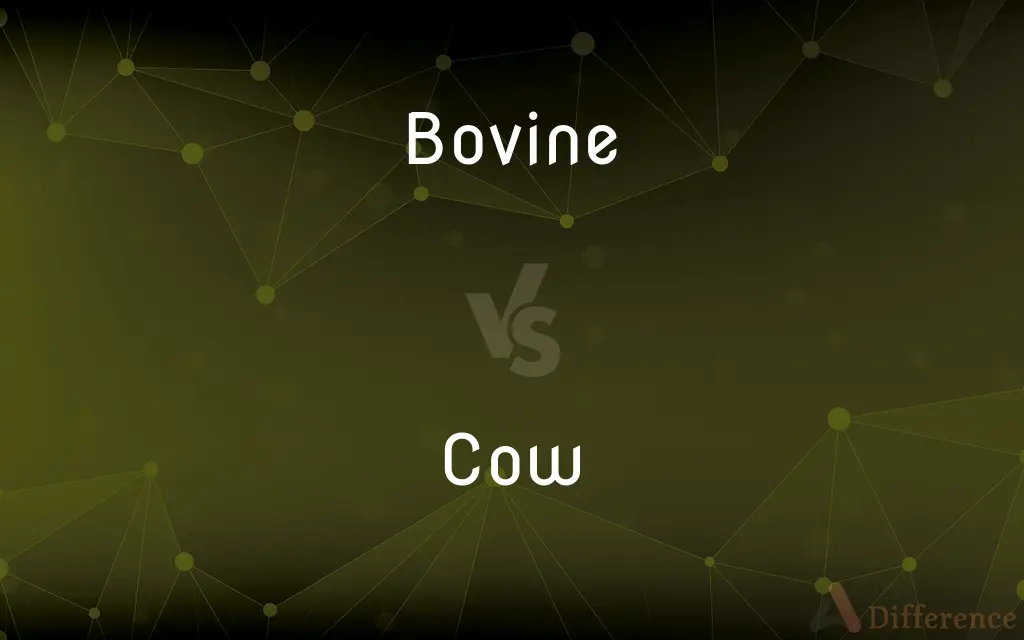Bovine vs. Cow — What's the Difference?
By Tayyaba Rehman & Urooj Arif — Updated on April 8, 2024
Bovines encompass a group of large, hoofed mammals, including cows, whereas cows specifically refer to female bovines bred for milk or meat.

Difference Between Bovine and Cow
Table of Contents
ADVERTISEMENT
Key Differences
Bovines represent a broad category within the family Bovidae, which includes species such as cows, bulls, buffaloes, and yaks. These animals share certain characteristics, like being ruminants with cloven hooves. On the other hand, a cow specifically refers to a female of the species Bos taurus or Bos indicus that has calved or is of milking age.
While bovines are known for their economic and cultural significance across various societies, providing resources such as milk, meat, and labor, cows hold a particular importance in dairy and beef production. Their role is pivotal in agriculture for the production of milk, dairy products, and meat.
The term "bovine" is also used in a scientific and medical context to describe anything pertaining to this group, including diseases like bovine spongiform encephalopathy (BSE). Conversely, the word "cow" is often used in a more specific agricultural or colloquial context, focusing on the animal's role in farming and daily life.
Bovines exhibit a wide range of physical and behavioral variations depending on the species, including differences in size, color, and habitat. Cows, being a subset of bovines, display variations influenced by breed, with distinctions in milk production, size, and temperament.
The conservation status and challenges faced by bovines vary significantly across species, with some being endangered due to habitat loss, hunting, and disease. Meanwhile, domesticated cows are numerous but face welfare and environmental concerns related to industrial farming practices.
ADVERTISEMENT
Comparison Chart
Definition
A group of large, hoofed mammals within the family Bovidae.
A female bovine, especially of the Bos taurus and Bos indicus species, that has calved or is of milking age.
Includes
Cows, bulls, buffaloes, yaks.
Only refers to female animals of milking or breeding age.
Usage
Scientific, medical, and general.
Agricultural, colloquial.
Significance
Economic, cultural, environmental impact.
Specific to dairy and beef production.
Conservation
Varies by species; some endangered.
Focus on welfare and environmental impacts of farming.
Compare with Definitions
Bovine
Characterized by slowness or dullness.
His bovine expression made it hard to guess what he was thinking.
Cow
Used in agriculture to refer to female animals bred for dairy production.
The farm specializes in high-yield dairy cows.
Bovine
Used to describe the subgroup of mammals within the Bovidae family.
Bovine genetics research has advanced the understanding of domestic cattle breeds.
Cow
A female bovine that has produced offspring or is used for milking.
The cow was led back to the barn for evening milking.
Bovine
Pertaining to the characteristics of cows or oxen.
The pasture was dotted with bovine creatures of various sizes.
Cow
A derogatory term used in various expressions to denote frustration.
I don’t give a cow’s cud about his excuses!
Bovine
Relating to or affecting cattle.
Bovine diseases can impact the entire cattle industry.
Cow
Informal term used to describe a large or unpleasant woman.
He rudely called the unfriendly clerk a cow.
Bovine
A member of the family Bovidae, which includes cattle, buffaloes, and yaks.
The sanctuary is home to several species of bovine.
Cow
The mature female of cattle of the genus Bos.
Bovine
Of, relating to, or resembling a ruminant mammal of the bovid subfamily Bovinae, such as a cow, ox, or buffalo, especially one in the genus Bos.
Cow
The mature female of certain other large animals, such as elephants, moose, or whales.
Bovine
Sluggish, dull, and stolid.
Cow
To frighten or subdue with threats or a show of force.
Bovine
An animal of the subfamily Bovinae, especially one of the genus Bos.
Cow
(uncommon) Beef: the meat of cattle as food.
The only meat I eat is cow.
Bovine
(not comparable) Of or pertaining to cattle.
Cow
(uncommon) Any bovines or bovids generally, including yaks, buffalo, etc.
Bovine
(not comparable) Belonging to the family, subfamily, tribe, or genera including cows, buffalo, and bison.
Cow
(biology) A female member of other large species of mammal, including the bovines, moose, whales, seals, hippos, rhinos, manatees, and elephants.
Bovine
Sluggish, dull, slow-witted.
Cow
A woman considered unpleasant in some way, particularly one considered nasty, stupid, fat, lazy, or difficult.
Bovine
An animal of the family, subfamily, tribe, or genera including cattle, buffaloes and bison.
Cow
(mining) A chock: a wedge or brake used to stop a machine or car.
Bovine
Of or pertaining to the genus Bos; relating to, or resembling, the ox or cow; oxlike; as, the bovine genus; a bovine antelope.
Cow
To intimidate; to daunt the spirits or courage of.
Con artists are not cowed by the law.
Bovine
Having qualities characteristic of oxen or cows; sluggish and patient; dull; as, a bovine temperament.
The bovine gaze of gaping rustics.
Cow
The mature female of bovine animals.
Bovine
Any of various members of the genus Bos
Cow
The female of certain large mammals, as whales, seals, etc.
Bovine
Of or relating to or belonging to the genus Bos (cattle)
Cow
A chimney cap; a cowl
Bovine
Dull and slow-moving and stolid; like an ox;
Showed a bovine apathy
Cow
A wedge, or brake, to check the motion of a machine or car; a chock.
Cow
To depress with fear; to daunt the spirits or courage of; to overawe.
To vanquish a people already cowed.
THe French king was cowed.
Cow
Female of domestic cattle:
`moo-cow' is a child's term
Cow
Mature female of mammals of which the male is called `bull'
Cow
A large unpleasant woman
Cow
Subdue, restrain, or overcome by affecting with a feeling of awe; frighten (as with threats)
Common Curiosities
How do bovines contribute to the environment?
Bovines can impact the environment through grazing, which affects plant growth and ecosystem dynamics, but their farming also raises concerns about greenhouse gas emissions and land use.
How do bovines communicate?
Bovines communicate through vocalizations, body language, and scent marking, with variations in behavior and communication across species and breeds.
What products do cows provide?
Cows are primarily known for providing milk, which is processed into dairy products, and meat from beef cattle.
What is the difference between bovine and cow?
Bovine refers to the group of mammals including cows, bulls, and buffaloes, while cow specifically denotes a female bovine of milking or breeding age.
Are all cows used for milk production?
While many cows are bred for dairy production, some are kept for breeding or raised for beef.
Can the term bovine refer to males and females?
Yes, bovine is a gender-neutral term that can refer to both male and female members of the species.
What is the lifespan of a cow?
The average lifespan of a cow is around 20 years, though this can vary based on breed and living conditions.
Are all bovines domesticated?
No, while many bovines such as cows and bulls are domesticated, there are also wild species, like the African buffalo.
Is "cow" a scientific term?
Cow is more commonly used in agricultural and colloquial contexts, though it is recognized in scientific terminology when referring to female individuals of certain species.
Can bovines form social bonds?
Yes, bovines, including cows, are social animals that form bonds within their herds, showing preferences for certain individuals.
How are bovine species conserved?
Conservation efforts for bovine species include habitat protection, breeding programs, and legal protections against hunting and poaching.
Are there any ethical concerns with bovine farming?
Yes, ethical concerns include the treatment of animals in industrial farming, environmental impacts of livestock agriculture, and the sustainability of meat and dairy production.
How can I contribute to bovine conservation?
Supporting sustainable farming practices, advocating for animal welfare, and contributing to conservation organizations are ways to help protect bovine species.
What challenges do bovines face today?
Bovines face challenges from habitat loss, climate change, diseases, and issues related to industrial farming practices.
Do cows play a role in any cultural practices?
Yes, cows hold significant cultural and religious importance in many societies, often symbolizing abundance, fertility, and peace.
Share Your Discovery

Previous Comparison
Conger vs. Eel
Next Comparison
Lahar vs. LandslideAuthor Spotlight
Written by
Tayyaba RehmanTayyaba Rehman is a distinguished writer, currently serving as a primary contributor to askdifference.com. As a researcher in semantics and etymology, Tayyaba's passion for the complexity of languages and their distinctions has found a perfect home on the platform. Tayyaba delves into the intricacies of language, distinguishing between commonly confused words and phrases, thereby providing clarity for readers worldwide.
Co-written by
Urooj ArifUrooj is a skilled content writer at Ask Difference, known for her exceptional ability to simplify complex topics into engaging and informative content. With a passion for research and a flair for clear, concise writing, she consistently delivers articles that resonate with our diverse audience.
















































